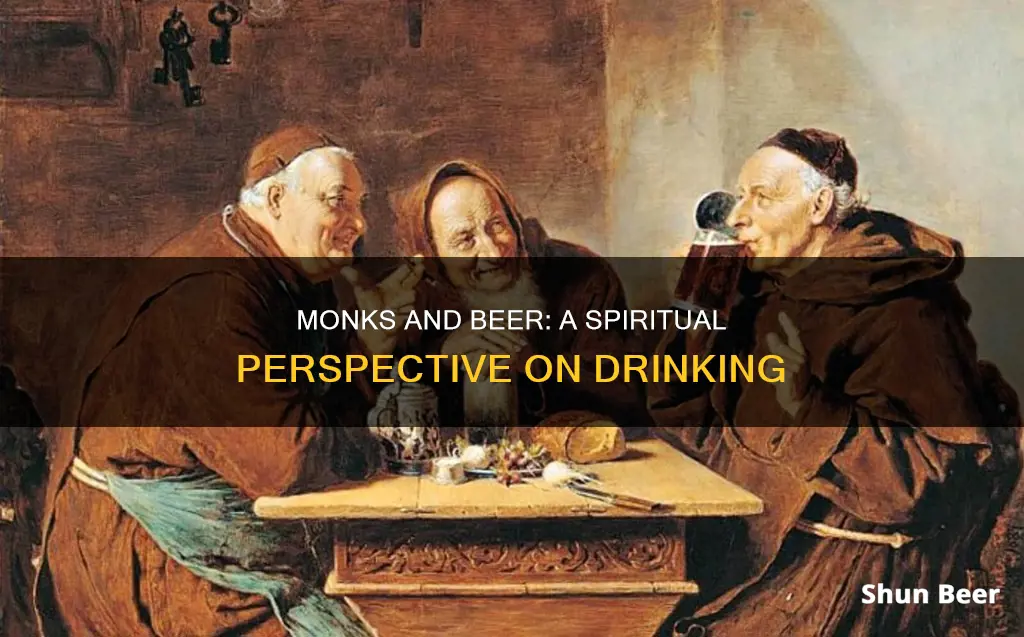
For centuries, monks have been brewing and drinking beer. In fact, during the Middle Ages, beer was the most consumed beverage in Europe, and most of the brewing was done by women. Monasteries started brewing beer as early as the 5th century, and at its peak, over 600 monasteries in Europe were brewing their own beer. The monks followed a principle of being completely self-sufficient and made it their duty to provide pilgrims and visitors with food and drink. Beer was also an important part of the monks' diet and was considered safer to drink than water. Today, several monasteries around the world still brew beer, and Trappist monks even have a certification process for their beer.
| Characteristics | Values |
|---|---|
| Beer consumption by monks | Beer was considered safer than water and monks drank up to four liters of ale per day. |
| Beer brewing by monks | Beer was brewed by monks as early as the 5th century and at its peak, over 600 monasteries in Europe were brewing their own beer. |
| Beer and religion | Most Christians find it acceptable to consume and handle wine, beer, and spirits. |
| Beer and fundraising | Beer sales helped monks fund the rebuilding of monasteries and other historic buildings. |
What You'll Learn

Why do monks brew beer?
Monastic breweries have evolved since their inception, but the reasons for monks brewing beer are rooted in history. During the Middle Ages, beer was the most consumed beverage in Europe, as it was safer than drinking water. Most of the brewing was done by women, who used poor-quality ingredients and lacked knowledge about sanitation, resulting in spoiled and poor-quality beer.
Then, Cistercian monks entered the brewing scene and transformed the process. Monasteries began brewing beer as early as the 5th century, with over 600 monasteries in Europe brewing their own beer at its peak. The monks valued self-sufficiency and providing food and drink to pilgrims and visitors. As beer was the preferred drink, it made sense for them to brew their own, and it also generated income.
The monks approached brewing with dedication, meticulously recording their recipes and striving for excellence. They believed that working for God required producing the best beer possible, and a subpar product would be a significant offence. To meet the growing demand, they developed mass-production techniques and added hops to balance sweetness and act as a preservative.
The original monastery breweries in the Middle Ages had three separate brewing areas, each producing a different quality of beer. One batch was for sale to customers and travellers, another was given to the poor, and the third was for the monks' consumption. The monks consumed up to four litres of ale per person per day and relied on beer for nutrition during fasting periods.
Mixing Beer and Wine: What Happens When You Do It?
You may want to see also

Is beer safer than water?
In the Middle Ages, beer was the most consumed beverage in Europe. Beer was considered safer to drink than water, and it was also refreshing and hearty. It was commonly consumed by everyone, including children and the elderly. However, this belief was not based on the knowledge that water could carry diseases, as this idea is relatively modern. Instead, people judged water quality based on smell and flavour. Those who could afford it would opt for clean water.
During this period, most brewing was done by women, who used poor-quality ingredients and lacked knowledge about sanitation, often resulting in spoiled or low-quality beer. When monasteries began brewing beer, they revolutionized the process. The monks aimed for the best possible product, believing they were working for God, and kept careful records of their recipes. They also added hops, which balanced the sweetness of the malt and acted as a preservative.
The beer produced by monks was so superior that it became a popular choice, and even a necessity, for many. It was consumed for its nutritional value and calories, especially by those engaged in manual labour. "Small beer," with an alcohol content of less than 2.8%, was commonly consumed in the mornings to provide energy for the day ahead.
While beer was widely consumed, it did not replace water, which was still accessible and consumed by the majority. Water was also mixed with wine or honey to improve its flavour. Therefore, while beer was considered safer and had additional benefits, water was still a significant part of people's diets during this time.
White Tongue and Beer: Is It Safe to Drink?
You may want to see also

Do monks drink their own beer?
Monasteries have been important breweries for centuries, with monks considered highly skilled beer brewers. In the Middle Ages, beer was safer to drink than water, and monks would offer it to travellers and pilgrims who arrived at the monastery. Beer was also used to sustain the monks during fasting periods, as they were not permitted to eat much during this time.
Monks certainly drank their own beer, and large quantities of it. Historical records indicate that each monk was allowed up to five litres of beer per day. The beer they consumed was lower in alcohol content than modern beer.
The original design of monastery breweries included three separate brewing areas, each producing a different quality of beer. One was for travellers and customers, one was given to the poor, and the third was for the monks' own consumption.
Monks took great pride in their beer, believing that they needed to make the best product possible as they were working for God. They kept careful records of their recipes and worked hard to improve their brewing techniques.
Today, several monasteries around the world continue to brew beer, including the Trappist monks, who have a certification process for their beer.
Drinking Beer in Public: Japanese Laws and Customs Explained
You may want to see also

Do monks sell their beer?
Yes, monks do sell their beer. In fact, brewing beer is a centuries-old tradition for monks, particularly those of the Cistercian and Trappist orders.
Monasteries started brewing beer as early as the 5th century and, at its peak, over 600 monasteries in Europe were brewing their own beer. The monks followed a principle of being completely self-sufficient and also made it their duty to provide pilgrims and visitors with food and drink. Beer was the beverage of choice at the time, so it made sense for monks to brew their own.
Today, several monasteries around the world still brew beer, and some even have a certification process for their beer. Authentic Trappist beers are brewed and sold mainly in European monasteries, with only one North American monastery actively brewing and selling beer—located in Spencer, Massachusetts. However, some monastic beers are exported and can be found outside of Europe, such as Chimay, Orval, Rochefort, and Westmalle.
The money earned from beer sales is used to fund the monks' works and charitable causes, as well as to cover the living expenses of the monks and the maintenance of the monastery and its grounds. Any remaining profits are donated to charity or used for social work and to help those in need.
Monks have also played a significant role in the history of brewing, with the first large-scale breweries in Europe and many advances in brewing techniques and technology attributed to them.
Yoga and Beer: A Relaxing, Fun Workout
You may want to see also

What are the rules for monks drinking beer?
Drinking alcohol is prohibited by some of the world's major religions, such as Buddhism, Islam, and certain branches of Hinduism. However, monks of the Catholic faith, which is inherently linked to the consumption and creation of alcohol, have a long history of brewing beer.
During the Middle Ages, beer was the most consumed beverage in Europe, and it was safer than drinking water. Monasteries started brewing their own beer because it was the beverage of choice, and it was a great way to make money. The monks believed that they needed to make the best product possible since they were working for God, and a sub-par beer would be a major offense. They kept careful records of their recipes, worked tirelessly to improve their beer, and figured out new ways to mass-produce it. The original monastery breweries included three separate brewing areas, each producing a different quality of beer: one for customers and travellers, one for the poor, and one for the monks' own use. The monks drank up to four litres of ale per day and relied on beer for nutrition during fasting.
Today, several monasteries around the world still brew beer, and Trappist monks even have a certification process for their beer. Authentic Trappist beers are brewed and sold mainly in European monasteries, and the profits may only be used to meet the needs of the community.
Beer Sleeves: Do They Keep Drinks Cool?
You may want to see also
Frequently asked questions
Yes, monks can drink beer. In fact, for most Christians, it is acceptable to consume and handle wine, beer, and spirits.
Beer was considered safer to drink than water during the Middle Ages, especially during the many plagues that struck Europe. Monks also drank beer for nutrition during fasting.
Yes, monks have been brewing beer since the 5th century. At its peak, over 600 monasteries in Europe were brewing their own beer. Monks brew beer for commercial sale and consumption, and travelers from across the globe can taste the beers monks make.
Some examples of beers brewed by monks include Chartreuse Liquor, Aromas De Montserrat, and Buckfast Tonic Wine.







